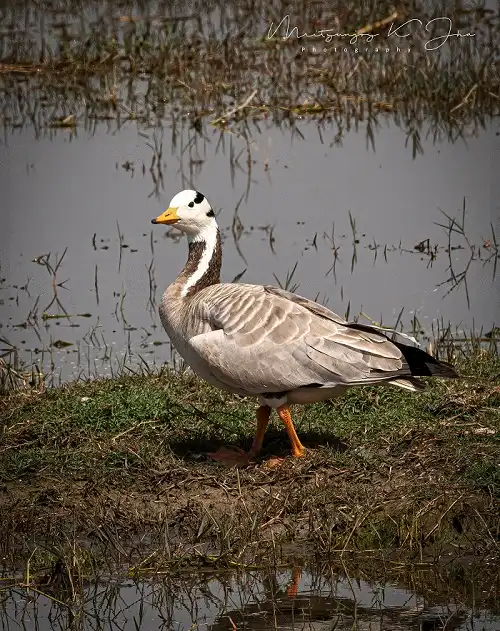<p>
<strong>They come from far north every year, flying over the highest peak in the world &ndash; Mt. Everest.</strong></p>
<p>
To get to India, the Bar-headed geese have to fly over the difficult&nbsp;Himalayas, the world&#39;s tallest mountain range which rises to 29,035 feet (8,850 meters). The researchers found that the geese reach an average height of nearly 21,120 feet (6,437 meters) during their travels. The migration takes about two months and covers distances of up to 5,000 miles (8,000 kilometers). But the&nbsp;last leg of their trip is astounding. These stamina birds fly 1000km non-stop for &nbsp;&nbsp;8 straight hours.</p>
<p>
No other creature on Earth comes close to making a similar high-altitude migration. Indeed, to survive the same rapid change in altitude, you or I would need a lengthy period of acclimatisation. But the Bar-headed geese already has all the physiological adaptations it needs to take on such an arduous migration. According to various researchers, the scientists found that muscles of these high fliers use oxygen more efficiently than other birds, and their lungs are proportionally much bigger than other ducks, geese and swans.</p>
<p>
George Lowe, the New Zealand born climber who supported Edmund Hillary and Tenzing Norgay&#39;s ascent in 1953, claimed that&nbsp;he had seen the geese flying over the top of Mount Everest, &quot;Geese tend to honk a lot as they fly..&rdquo; he wrote, &rdquo;the distant honking of these birds flying miles above me unseen against the stars.&rdquo;</p>
<p>
<iframe allow="accelerometer; autoplay; clipboard-write; encrypted-media; gyroscope; picture-in-picture" allowfullscreen="" frameborder="0" height="315" src="https://www.youtube.com/embed/4fOkslqAnA8" title="YouTube video player" width="560"></iframe></p>
<p>
After decades of research,&nbsp;it turned out that these Bar-headed geese are a bit more level-headed when planning their gruelling trip each year&nbsp;from their breeding areas in Mongolia, the Tibetan Plateau and northern China to their wintering sites in India. These birds cross over the Himalayas using less than ten percent of the oxygen available at sea level, reaching altitudes of up to 9,000 m with no help from any tailwinds. Instead of climbing to dizzying altitudes and flying in a straight line over the mountain tops, they follow a &ldquo;roller-coaster&rdquo; route, closely.&nbsp;</p>
<p>
The researchers say that these birds prefer to fly at night, when conditions are relatively calmer. Temperatures are also colder in the night, making the air denser. Denser air carries more oxygen and increases the lift that the birds&#39; wings can generate as they flap, suggesting that the birds may rely on those effects as well.</p>
<p>
<img alt="Geese" src="https://www.indianarrative.com/upload/news/_DSC1070_pair_Bar_Headed_Goose_@_Bharatpur.webp" style="width: 100%; height: 100%;" /></p>
<p>
The first time I observed them was in Bharatpur sanctuary in Rajasthan in 2018 and they have been my favourite bird species ever since. Since then, I have seen wetlands of NCR, Chambal biodiversity park and there are reports that suggest that they have been sighted in major wetlands of the country. In NCR, Sultanpur lake is one of&nbsp;their favourite places.&nbsp;&nbsp;</p>
<p>
An adult goose weighs about 3 kg and stands about two feet high. Two horizontal black stripes on the back of the bird&#39;s white head give the species its name. They are very pretty birds&nbsp;but&nbsp;they don&#39;t look like super athletes&nbsp;who can fly so high.</p>
<p>
<img alt="geese" src="https://www.indianarrative.com/upload/news/mkj.webp" style="width: 100%; height: 100%;" /></p>
<p>
Bar-headed geese, in India, are known as Raj Hans. In Indian mythology, the geese is referred as &ldquo;Hamsa&rdquo; and in another interpretation, this is likely to be Kadamb in ancient and medieval Sanskrit literature where Hamsa generally refers to the swan.</p>
<p>
Julia York, who has been studying bar-headed geese wrote in her&nbsp;<a href="https://elifesciences.org/articles/44986 ">research</a>&nbsp;published in elife in 2019, &ldquo;The bar-headed geese have done that migration for millions of years before the Himalayas were as tall as they are now and the birds have been pushed as the mountains have moved up to go higher and higher.&rdquo;</p>
<p>
<strong>Also Read: <a href="https://www.indianarrative.com/culture-news/kingfisher-the-bird-which-inspired-a-bullet-train-in-japan-98157.html">Kingfisher: The Bird which Inspired a bullet train in Japan</a>&nbsp;</strong></p>
Bar-headed Geese: India’s winter guests come flying over Mt Everest
14

